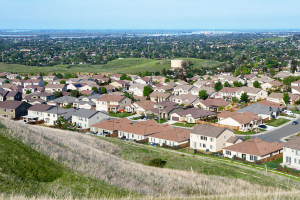
Compared to rural agricultural areas and cities, suburbs are some of the most wasteful settlements in the United States. When you really break it down, suburbs are nothing more than the midpoint between rural and urban areas. They have a population density that leans more towards cities, but they take up the space of a countryside. Unfortunately, this means that suburbs, though taking on the costs of both of these extremes, wind up receiving none of the benefits. From an economic stand point, they often combine the worst of both worlds.
Here’s a few quick examples of what I mean. In the city, the cost of housing is very expensive, but fortunately there are more job opportunities. In rural areas, rent and most basic goods are cheaper, but there aren’t nearly as many jobs in most cases. But in suburbia, you often get the high rents without the same job opportunities, which means you’ll probably have to commute to the city for work. That brings me to another example.
In the city you probably don’t even need a car. Everything you need is incredibly close and public transportation and taxi cabs are everywhere. If there is somewhere that is too far to walk to, you won’t have any trouble finding a ride. In the rural areas, you’re practically doomed if you don’t have a car, or know someone who can drive you, but at least there isn’t any congestion. In the suburbs, you get the long distances and the congestion. Plus, newer suburbs aren’t built with pedestrians in mind, and they don’t have nearly as many sidewalks and trails as the suburbs that were built several decades ago.
See what I mean? Suburbs often combine the worst of both worlds. This of course, also includes sustainability and self-sufficiency. Rural areas have great potential for both of those attributes and cities do not, but at least cities have more economic opportunities. Suburbs on the other hand, take up all of the space of that is typical of rural community but without any of the self-sufficiency, especially in regards to food production. Which is a shame, because they have a great potential to capture the best of both worlds, in terms of self-sufficient food production and economic opportunities.
Case in point, all over the world there are a growing number of so-called ‘agrihoods.’ These are essentially residential neighborhoods that are built around small farms. Having this in the suburbs means you could have the benefit of fresh sustainable produce, but still live in an area that has far more job opportunities. Given the growing interest in organic, and local food, these types of neighborhoods may be the wave of the future.
This farm-to-table residential model has been sprouting up everywhere from Atlanta to Shanghai. It involves homes built within strolling distance of small working farms, where produce matures under the hungry gaze of residents, where people can venture out and pick greens for their salads.
“Real estate developers are looking for the next big thing to set them apart,” said Ed McMahon, senior resident fellow with the Urban Land Institute in Washington. “That gives them a competitive advantage.”
There are many variations of the agrihood, McMahon said. “Some developers rent acreage to farmers,” he said. “Some set up non-profit C.S.A. (community-supported agriculture) programs. Some have the residents doing it (the growing) themselves.”
Agrihoods frequently include farmer’s markets, inns and restaurants sited in communal hubs where the edibles are processed or sold.
For now, these neighborhoods are very pricey. They are often built as gated communities, and are marketed primarily to second home buyers and retirees. While the cost of food is much cheaper, that alone isn’t nearly enough to offset the cost of housing.
Like most things in this world however, the cost is always higher for the first product to fall off the assembly line, so to speak. What will really drive down the cost, is when preexisting neighborhoods start to retrofit their surroundings into small, sustainable farms. The first of these retrofits will probably coincide with golf’s lagging popularity, which is causing hundreds of golf courses to close every year. That’s a lot of open space with plenty of water access, right in the middle of suburbia, and it’s ripe for the picking. Give it a few years, and you might start to see these farms pop up in neighborhoods near you.
This article was originally published at Ready Nutrition™ on February 16th, 2016







So, like suburbia, with gardens. Earthshaking.